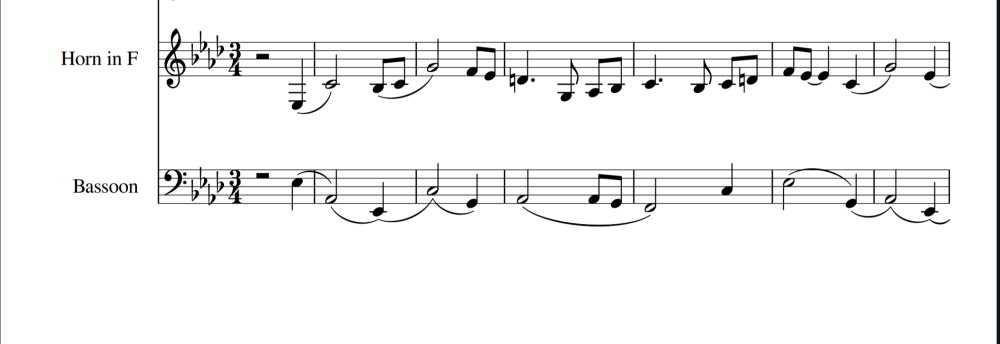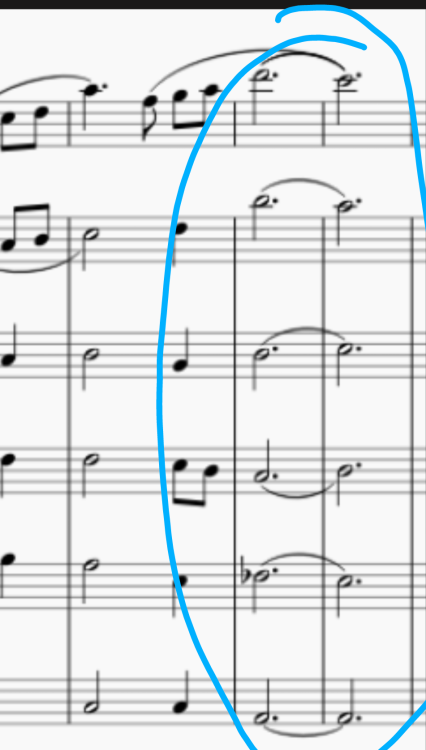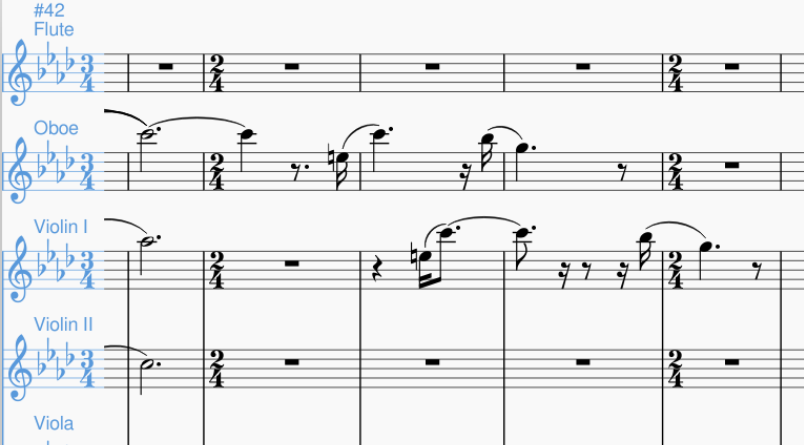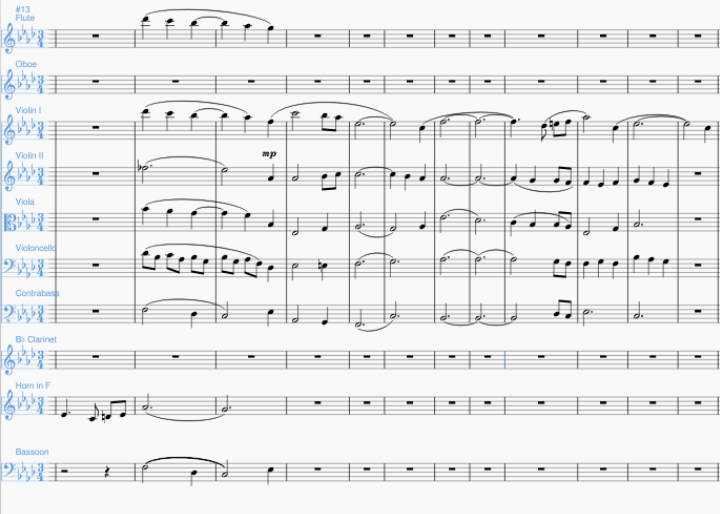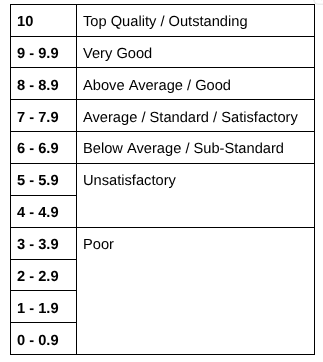All Activity
- Past hour
-
The Mewlips-Tone Poem for String Orchestra
Churchcantor replied to Churchcantor's topic in Orchestral and Large Ensemble
Anyway, I think this piece I wrote more than half my life ago has some legs. Too much dissonance for my old age...😉 -
The Mewlips-Tone Poem for String Orchestra
Churchcantor replied to Churchcantor's topic in Orchestral and Large Ensemble
I just had houseguests for about a week; James who I have forgiven, though he is still a bit gently ficked in the head, and his 38-year-old girlfriend of two months, Jaqueline, Jackie. She at least is pretty cool, and so is James, when he wants to be I suppose. It was fun for the first four days or so; lots of pot, beer, we partied! Then, I was left overnight with Jackie, and the next day, James has the Chutzpah to ask me if I had sex with her, did I even show her my dick? No, I did not! Day after that, he abandons her on Main Street and goes off with another girl. Day after that, Jackie gets arrested and spends the night in jail for drinking in front of Tri-Star, but she just brushed that off: good night's sleep and a $100 fine. Yesterday though when she got out early in the morning and got a Sheriff's Deputy ride back to my place, what do they do but have vigorous sexual intercourse when they thought I was asleep, under a bedspread thank god, and here I was looking over and seeing Mutual of Omaha's Wild Kingdom going on under the bedspread feet away! I tried to just look out the window, but it went on for quite a while. I guess I should be impressed; James has above average sexual endurance, but of course it was mainly embarrassing. They are gone for now, back to Gloucester, and I am once again left to my own devices. -
I was truly impressed by your depth of knowledge and clarity of explanation. I would be deeply honored and genuinely grateful if I could stay in touch with you or have the opportunity to take lessons and learn from you directly. Your guidance would mean a great deal to me, and I’m very eager to learn under your instruction. With sincere respect and appreciation, Kian Mahdian
-
Kian started following Monarcheon
- Today
-
Sonata no 21 in C minor ( binary form)
Vasilis Michael replied to Vasilis Michael's topic in Piano Music, Solo Keyboard
Don’t worry about it at all — and I didn’t take it the wrong way whatsoever. On the contrary, I really want to know how another musician perceives something from a different perspective than my own. Everything you said has a solid basis, and when those ideas make musical sense, they’re absolutely valid. Thank you again! I’d be very happy if you checked out my channel and listened to some of my other works — it would really mean a lot to me. -

Sonata no 21 in C minor ( binary form)
Monarcheon replied to Vasilis Michael's topic in Piano Music, Solo Keyboard
I'm glad you did! For me, I was going to have those reactions anyway, but obviously I'll have a different perspective. It's great we get to share potential reasons for feeling differently. Don't get me wrong; it's an incredibly smooth little sequence! It's actually possible that I thought it almost needed to stand out more, in a way, you know? Like the character is so different I might have wanted to hear it be a little wilder to reinforce that in my brain, you know? Not entirely sure. Kudos, again. Lovely stuff. -
Sonata no 21 in C minor ( binary form)
Vasilis Michael replied to Vasilis Michael's topic in Piano Music, Solo Keyboard
First of all, thank you so much for taking the time and care to listen to my work so attentively — I truly feel grateful for that. I’m really glad you liked it and appreciated the effort I put into it. Also, thank you very much for your feedback. If you’d like, I can share my own perspective on the points you mentioned. At 2:40, since there was a modulation to B major with the initial theme — and because of its nature, it didn’t really lead anywhere — the only way forward was through a series of modulations, starting with C-sharp minor. Then somehow, in a dynamic way, I had to wage a sort of “battle” of modulations to find my way back to the tonic. From my point of view, that section is actually one of my favorites; it just felt like it needed to happen that way. At 2:49, I wanted to keep that drone note more as a timbral element and to add a more dramatic texture due to the constant alternation between major and minor. From a technical standpoint, you could say it’s nothing particularly special — it’s really more about the color I wanted to convey. In general, I truly enjoy hearing everyone’s perspective and how each person approaches the piece with their own unique viewpoint — it’s very interesting. Once again, thank you, my friend, for your kind words and appreciation. Wishing you all the best! -
I was truly impressed by your depth of knowledge and clarity of explanation. I would be deeply honored and genuinely grateful if I could stay in touch with you or have the opportunity to take lessons and learn from you directly. Your guidance would mean a great deal to me, and I’m very eager to learn under your instruction. With sincere respect and appreciation, Kian Mahdian
-

Sonata no 21 in C minor ( binary form)
Monarcheon replied to Vasilis Michael's topic in Piano Music, Solo Keyboard
Wow, this is so pretty! I think my favorite thing about this are all these little moments that play with different dissonances: a. 0:21 holding onto the 7th into the EEC, b. 0:49 on the French 6th, technically resolving to V, bit leaving immediately after the silence. c. 3:32 holding onto fi. Maybe not unique per se, but treated with such a light touch that they really pop here! Good job! Only a couple sections I felt were a bit of a bigger change: 1. 2:40's sequence felt a little odd to me for some reason. It's a big moment, for sure, but maybe the sequence was just so rhythmically formulaic that it contrasted the unpredictable pleasantness of the rest of the piece enough to be marked for me. 2. 2:49's repeat of the low octave feels a little heavy-handed as well, but I get that you want to make the home key a little stronger after all the work you put into modulating. 3. Right at the very end, just a personal taste kinda gripe: going from 8 to 3 to 1 (scale degrees) in your highest voice feels like it's missing the 5, even though this is not an uncommon gambit. I actually quite liked the i chord with the third in the top voice because it balanced out the high SD 8. Obviously, all of the above are just personal taste things. This is a really excellently crafted work! -
aeolianspirit5 joined the community
-
Because it's not a passing chord. The type of 6/4 record refers to what the bass is doing. In this case, the E in the bass isn't a "passing" tone (i.e., it's not approached by step and left by step in the same direction), so it isn't a passing 6/4 chord. Now, the third chord in m. 3 is technically a correct passing chord, but odd because it's minor (although minor v's aren't uncommon passing chords) and the aforementioned poor voice spacing. Minor v chords definitely exist, but—in America, at least—you're just taught to always raise the leading tone in minor unless otherwise marked through figured bass. V would indeed have a B-natural, but your use of the minor v, at least where I teach, in and of itself would be suspect. Any diminished or augmented interval in the upper voices is forbidden (unless extremely niche circumstances I won't cover here). If you did make the alto a B-natural in m. 3, it would become an augmented fifth, which is augmented, so it's not permitted. I mean, I'm sure there's music that ends in IV like some sort of plagal half cadence, but for harmony exercises, we really only deal with Half Cadences, Perfect Authentic Cadences, and Imperfect Authentic Cadences, with plagal extensions and deceptive cadences as ways to lengthen a progression, not end one. Ending a phrase in IV is really odd because it's functioning as predominant, which implies there should be a dominant somewhere in there. Note your wording. Authentic cadences resolve to tonic. Half cadences merely end on the dominant. Most phrases and pieces end on tonic because they "feel" resolved. I'm not explaining it in detail here, but 6/4 chords were considered the most unstable because of a remnant from Renaissance-style practice where creating a fourth between the lowest sounding note and any upper voice was a huge problem. So we only use passing, neighbor, pedal, and cadential 6/4s because 6/4 chords are dissonances and need to be treated as such. The fact that you have two 6/4 chords in a row in m. 3 is wrong because you have two dissonant chords in a row, prevents proper resolution. To be clear, all of this is only true in terms of doing exercises. Exceptions in the repertoire exist all the time.
-
Tunndy started following I wrote this piece when I was pissed off
-
First of all, thank you very much for your analysis. Your review was very comprehensive and meticulous, and I learned a lot from it. It was extremely helpful, and I am very grateful. Could you please explain why, in measure three, the second chord is technically a passing chord but is considered incorrect? Why are students taught to avoid the minor V chord? And in measure three, shouldn’t V necessarily include a B natural? If it has a flat, is that considered wrong? Also, I didn’t quite understand your comment about the alto leap. Did you mean an augmented or diminished leap that you said is forbidden? I have one more question: don’t we have a half plagal cadence, similar to a half authentic cadence that ends on IV? Is it incorrect if a phrase ends on IV? Why must cadences resolve to a tonic? And why is the second inversion of the chord considered wrong? Could you please explain these points in detail?
-
First of all, thank you very much for your analysis. Your review was very comprehensive and meticulous, and I learned a lot from it. It was extremely helpful, and I am very grateful. Could you please explain why, in measure three, the second chord is technically a passing chord but is considered incorrect? Why are students taught to avoid the minor V chord? And in measure three, shouldn’t V necessarily include a B natural? If it has a flat, is that considered wrong? Also, I didn’t quite understand your comment about the alto leap. Did you mean an augmented or diminished leap that you said is forbidden? I have one more question: don’t we have a half plagal cadence, similar to a half authentic cadence that ends on IV? Is it incorrect if a phrase ends on IV? Why must cadences resolve to a tonic? And why is the second inversion of the chord considered wrong? Could you please explain these points in detail?
-
Gothic Tarantella for Violin and Clavichord
Vasilis Michael replied to PeterthePapercomPoser's topic in Chamber Music
This piece, to my ears, is truly perfect. Amazing. You managed—through the character you wanted to convey—to create something very special. Stylish, with wonderful and unexpected harmonic progressions. The transition to the slow section was dramatic and surprising. Overall, an outstanding piece. You’re a remarkable composer -
Vasilis Michael started following Gothic Tarantella for Violin and Clavichord
-

Nocturne in C-sharp minor
Henry Ng Tsz Kiu replied to Henry Ng Tsz Kiu's topic in Piano Music, Solo Keyboard
Thx bro! I don't know why I wrote like this then but I did. The fugato is quite an unsuccessful attempt; I was not that good at counterpoint then! If this piece is written by me now, I would defintitely cut the whole fugato section out since it is totally unnecessary to retain it. For the harmonies, when I wrote those neapolitan harmonies I didn't even know the term "Neapolitan Sixrh" lol! Henry -

Gothic Tarantella for Violin and Clavichord
Henry Ng Tsz Kiu replied to PeterthePapercomPoser's topic in Chamber Music
Yo Peter, This one is really funny to listen to, nothing to add given how @Monarcheon already given such detailed advice. I like the middle section in Ab major the most. Thank for sharing! Henry -
Sonata no 21 in C minor ( binary form)
Vasilis Michael replied to Vasilis Michael's topic in Piano Music, Solo Keyboard
Exactly as you say, my dear friend. This kind of music and mood is what truly expresses me. That’s my temperament as a person, and it naturally comes out in my music. -

Sonata no 21 in C minor ( binary form)
Henry Ng Tsz Kiu replied to Vasilis Michael's topic in Piano Music, Solo Keyboard
Yeah, because I have just finished listening the 129 examples of the Sonata book I have read, and before writing the Adorned Zither Piano Pieces I have some energy left to review something! I think this one is more in major mode simply because the mood is more light hearted and joyful! And Schubert always did that by giving some slight hope in major mode before returning to minor which makes the tragedy more tragic, thus the minor quality more strongly. Henry -
Henry Ng Tsz Kiu started following Sonata no 21 in C minor ( binary form) and Fantasy impromptu Orchastrated
-
Hey Pabio @Fugax Contrapunctus! I really love this one! Your canonic skill is really mature here. The imitation goes fourth below in each entry and thus there's constant modulation within the piece in the circle of fifth. However it doesn't sound strange at all, but on the contrary very fluent. The canon is of course very technical to be written, but this one doesn't sound technical at all , but conversely enhance the flow and drama of the piece, which build up really well to the climactic end! Thx for sharing! Henry
-
Sonata no 21 in C minor ( binary form)
Vasilis Michael replied to Vasilis Michael's topic in Piano Music, Solo Keyboard
Dear Henry, First of all, I’m glad to see you again after such a long time, and I always look forward to hearing your new compositions, which are truly remarkable. Thank you very much for your kind words. From a technical point of view, I consider this sonata to be my best work so far. As for the modulations — being the greatest admirer of Schubert, who along with Mozart is my favorite composer — moving from one tonality to another is something that haunts me in a pleasant way, of course, and I feel it’s one of the great tricks that helps me evolve each time. This sonata may be in C minor, but it carries a touch more of the major mode — and when it returns to the minor, that minor character is heard even more intensely. Personally, I tend to feel the minor quality more strongly when it emerges within a major key rather than purely in a minor one. I don’t know, maybe that sounds unorthodox or strange, but that’s the feeling it gives me. Once again, thank you for your kind words. -
Hello @Justin Gruber! Welcome to the forum and thx for joining the Halloween Competition! I really like this light hearted piece which for sure match the Halloween theme. Changing meters, naughty interactions between the instruments, as well as some funny dissonance and oblique harmonic motions. I like in the structure that after reaching Section K the tonality is more affirmed in C major even with some later more dissonant passages, and then more reflective passages before the ending, and then section P brings back the opening. This really gives a narrative to the whole piece. Thx for sharing! Henry
-

Sonata no 21 in C minor ( binary form)
Henry Ng Tsz Kiu replied to Vasilis Michael's topic in Piano Music, Solo Keyboard
Hey @Vasilis Michael! I really like the hunting character for this Sonata! Lovely touch and articulation for playing this. The modulations get really adventurous in the development from B major to C# minor and then Eb minor and then F# minor, then F major, Db major and back to C major/minor. It's really Schubertian to have this kind of chord progression! Thx for sharing this light hearted piece! Henry -

Fall 2025 Halloween Competition
Omicronrg9 replied to PeterthePapercomPoser's topic in Monthly Competitions
Let's go. I'll try. Deadline a bit bad to me but I'm sure something can be done. -
PeterthePapercomPoser started following Sonata no 21 in C minor ( binary form)
-
Vasilis Michael started following Sonata no 21 in C minor ( binary form)
-
Hello again, my friends. Here is the latest sonata in Binary form that I’ve written. From a technical point of view, I believe it’s my best one, and I feel quite happy about it. Musically, like every piece, it’s different and has its own beauty. I hope you like it.
-

Oboe Concerto
GospelPiano12 replied to GospelPiano12's topic in Incomplete Works; Writer's Block and Suggestions
Here is the French Horn + Bassoon intro/prelude material I was writing. I'm feeling mehh about it, but only because it doesn't really connect to the piece imo. Here is the stuff that I am just in LOVE with though. The way the ensemble creates this movement is just wonderful to me. Still working on filling in the string parts and incorporating the French Horn and Bassoon into these sections with the melody. However, I think that's too big of a start to the piece, so I'm still brainstorming on how I can lead into that -> hence the F.H & Bassoon intro/prelude. Now unto the fun stuff Not sure if anyone is familiar with the work of Pierre Boulez, but if you are please let me know. My idea for this section is to have these big jumps up and down in different intervals and have the ensemble mimic and echo those movements in the rests of the oboe. So that way, we get a very, for lack of a better word, "quacky", and almost disjointed sound. The reason I mention Boulez is because of his piece, "Le Marteau sans Maître", that has the exact sound I'm going for. -> wanting to see if I can create a system that will make this portion easier to write,I want it to be less "musical" than the more elegant (only word that's coming to mind), lyrical section. (This would be coming after this part) -
.thumb.png.8b5b433a341551e913a34392660bc95b.png)
Fall 2025 Halloween Competition
PeterthePapercomPoser replied to PeterthePapercomPoser's topic in Monthly Competitions
This is a very informal competition. Usually, in a formal competition we would have dedicated judges who used judging criteria and scoring definitions. But, then, if they were a judge they would not be allowed to participate in the competition themselves. And the submissions would also have to be kept anonymous to stave off any impression of favoritism. But since, ultimately, this competition is just a fun challenge without monetary rewards, we decided to do away with all that formality. But, we would be honored if you (or everybody really) donated their very valuable time to review the music submitted in as detailed a way as you feel is necessary and appropriate! AND, if you review all the participant's works you get an "Ardent Reviewer" badge which everyone will be able to see in your profile! In previous, formal competitions we used the following scoring definitions: And the following scoring categories: It would honor us if you (or anybody who feels up to the challenge) used these categories and definitions to review the pieces submitted! Thank you for whatever time and effort you're willing to give!



